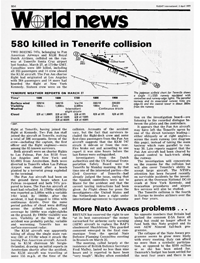Like all initial news stories about aircraft accidents, Flight International's reports provided what little information was available. In the case of these three serious accidents the results were clear, but the causes were obscured until investigation provided the perspective
THE ACCIDENTS THAT CHANGED THE WORLD
The worst accident ever
 |
|---|
The worst accident involving a single aircraft
On 12 August 1985, a Japan Air Lines 747SR (short-range version) flight took off for a domestic flight from Tokyo to Osaka. Serious mistakes had been made in a repair carried out at Boeing to the aircraft's rear pressure bulkhead, which had been damaged in a tailstrike landing seven years earlier. The bulkhead suffered structural failure, causing the tail-cone and a large part of the fin to separate, and rendering all the control systems and hydraulics useless, leaving the crew with only engine controls. The crew kept the aircraft airborne for half an hour, but 520 people of the 524 on board were killed when the aircraft crashed on a mountain ridge.
The accident that changed survivability
On 22 August 1985 at Manchester airport in the UK, a Boeing 737-200 of British Airtours began take-off when it suffered a catastrophic failure of its left engine, fragments of which punctured the wing fuel tank next to the engine releasing fuel on to hot components and starting a severe fire in the left wing. The crew abandoned take-off when they heard the engine fail, and turned off the runway before stopping, putting the fire upwind of the hull, which burned through. In casualty numbers the accident was not historic: there were 55 deaths among the 137 on board. But the accident report opened a debate about whether the deaths might have been avoided, and the subsequent research about survivability procedures, cabin materials, and a landmark study of human behaviour during aircraft evacuation has radically improved crash survival.
Source: Flight International























